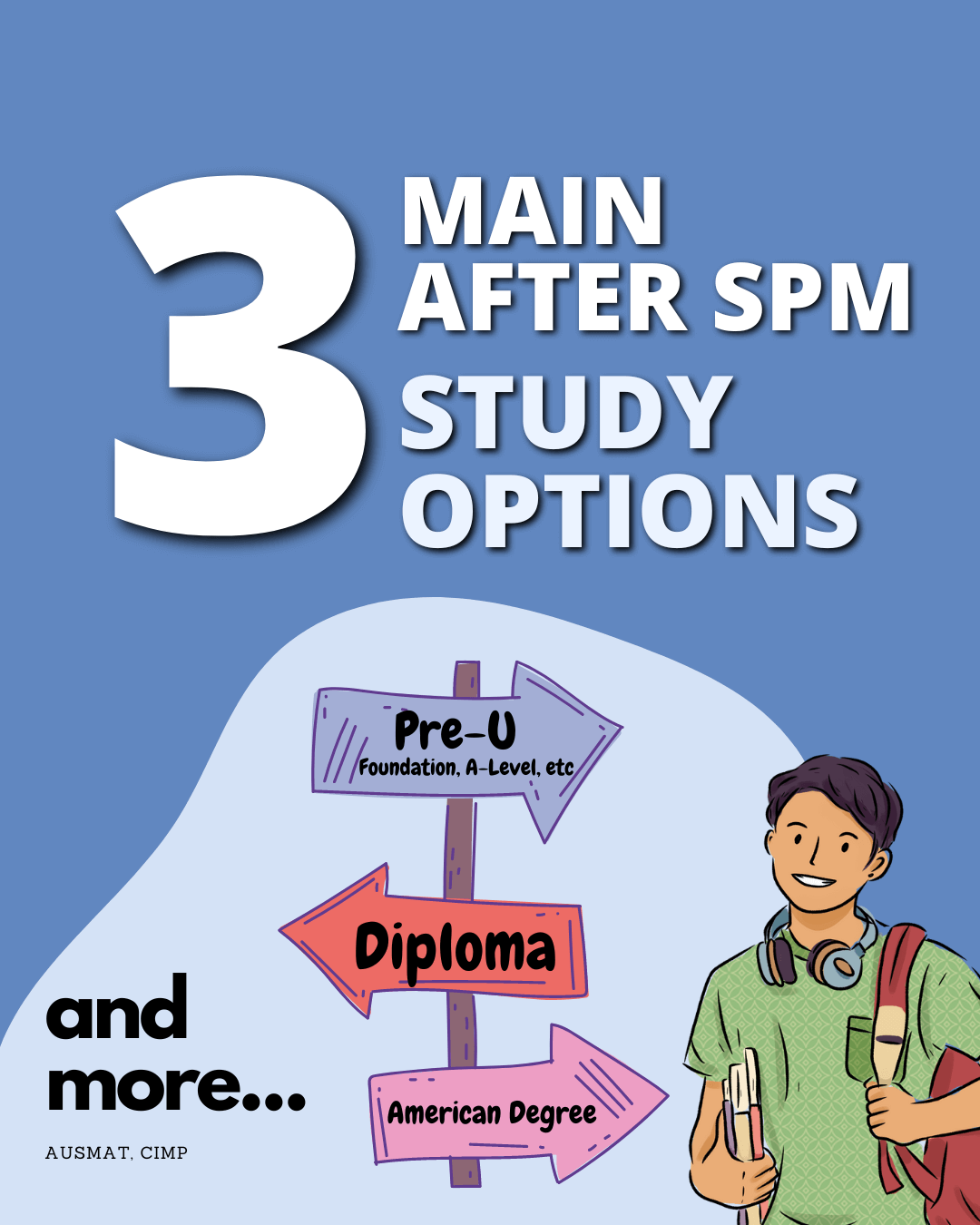Just finished SPM and wondering what to do next?
Whether you passed with flying colours or didn’t get 5 credits, don’t stress, there are still plenty of options for what to do after SPM in Malaysia. From diploma and foundation programmes to A-Levels, ADP, and even certificate courses for low SPM results, this guide has got you covered.
Now that SPM is behind you, it’s time to start thinking about what’s ahead.
Want to know the best courses after SPM? Curious whether foundation is better than STPM or what to choose if you didn’t meet the credit requirements?
We’ll break down all your study pathways and help you figure out the smartest move in 2025, so you can make an informed decision about your higher education journey in Malaysia.
So chill out and let’s explore your study options after SPM together. You’ve got this.
Popular Study Pathways After SPM

After SPM, you have different study pathways to choose from based on what you like and what you want to do in the future. Here are some of the pathways you can take:
- STPM / Malaysian Matriculation
- Pre-University Courses (Foundation, A-Level, AUSMAT, SACE, etc.)
- Diploma Courses
- American Degree Program (ADP)
Each of these courses after SPM leads to different types of higher education or career opportunities.
Let’s break down what each option involves, how long it takes, and which one might be the best fit for your future goals.
a. STPM and Malaysian Matriculation (Matrikulasi)
After completing SPM, there are two government-funded pre-university pathways you can pursue: STPM (Sijil Tinggi Persekolahan Malaysia) and Malaysian Matriculation (Matrikulasi).
STPM (Sijil Tinggi Persekolahan Malaysia)
The STPM is an advanced-level qualification recognized internationally, equivalent to the A-Level. This 2 years program is offered by selected local schools and is a highly competitive route for students who want to pursue higher education. Students enrolled in STPM must choose from a wide range of subjects, with a focus on academic disciplines.
STPM provides a broader foundation, making it a great option for students planning to apply to both local and international universities.
Malaysian Matriculation (Matrikulasi)
The Malaysian Matriculation Program is a 1 to 2 year course that offers students a solid foundation in various fields such as Science, Accounting, Professional Accounting, and Engineering. This program is subsidized by the government, making it an affordable option for many students.
Matrikulasi is ideal if you're planning to study at a public university in Malaysia. While the course duration is shorter compared to other pre-university programs, it provides a solid foundation for your future degree.
b. Pre-University Programs
Pre-university programs provide the necessary academic foundation for SPM leavers to progress into a Bachelor’s degree. These programs typically span from one to two years and offer flexible pathways for students, whether they choose to study in Malaysia or abroad.
Here are the some Pre-U options available in Malaysia:
- Foundation
- A-Level
- Australian Matriculation (AUSMAT)
- Canadian Matriculation
i. Foundation Studies
Many colleges and universities in Malaysia offer Foundation programs in various fields such as science, arts and business.
These programs usually span one year and provide a solid academic foundation for students intending to pursue a degree.
The benefits of foundation studies include the opportunity to explore different disciplines and a smoother transition to a Bachelor’s degree at the same university.
Pros:
-
Shorter duration than A-Level (1 year vs 1.5-2 years)
-
Lower cost
-
Smooth progression to a Bachelor’s degree at the same university
-
Recognized by other universities in Malaysia
Entry requirements:
- SPM or IGCSE or equivalent with minimum 5 credits including English.
Here are some institutions that provide this Foundation program:
ii. A-Level
A-Levels, short for Advanced Level, are internationally recognized qualifications widely accepted by universities worldwide.
They are typically a two-year program and offer in-depth knowledge and critical thinking skills.
Students are required to undertake a minimum of 3 subjects. Some students can even take up more than 3 subjects if they want to enroll in a more competitive university such as Oxford or Cambridge.
A-Levels is suitable for students who have a strong command of English, are academically disciplined, and are able to prepare well for exams, and may be planning to study abroad or want to keep options open in terms of continuing their Bachelor’s degree in Malaysia or abroad.
Pros:
- Recognized and accepted by universities all over the world including Malaysia
- Provides a flexibility to students in deciding to continue to Bachelor’s degree in Malaysia or abroad
Entry requirements:
- SPM or IGCSE or equivalent with minimum 5 credits including English.
Here are some institutions that provide this A-Level program:
iii. Australian Matriculation (AUSMAT or SACE International)
This program follows the Australian education system and allows students to pursue a range of subjects.
There are 2 types of Australian matriculation offered in Malaysia:
- Australian Matriculation (AUSMAT)
- SACE International (South Australian Certificate of Education)
Both of them are based on the Australian education system and both incorporate a combination of coursework and final exams which ultimately leads to an Australian Year 12 qualification.
AUSMAT is administered by and follows the curriculum of the Western Australia Certificate of Education (WACE). You will be assessed and graded based on 50% coursework and 50% final examination.
SACE International is administered by the SACE Board of South Australia. You will be assessed and graded based on 70% coursework and 30% final examination.
Benefits of these Australian matriculation programs include flexibility in subject choices, development of independent study skills, and preparation for studying in Australia.
Choosing an AUSMAT or SACE International program is not only beneficial if you plan to pursue a Bachelor's degree in Australia, but it also holds recognition worldwide, including by universities in Malaysia.
This means that even if your plans to study in Australia are canceled, you can still secure admission into a Malaysian university without encountering any obstacles.
Pros:
- Shorter duration than A-Level
- Recognized and accepted by universities worldwide including in Malaysia
- Assessment is based on coursework and final exam
Entry requirements:
- SPM or IGCSE or equivalent with minimum 5 credits including English.
AUSMAT and SACE International are offered by a few private colleges in Malaysia such as:
iv. Canadian Matriculation
The Canadian International Matriculation Program (CIMP) or also known as Canadian Pre-University (CPU) is an option for students interested in pursuing a Bachelor’s degree at a university in Canada.
CIMP is a globally recognized Year 12 secondary school curriculum originally from Ontario, Canada. It holds approval from Malaysia's Ministry of Education, and its delivery is overseen by the Ontario (Canada) Ministry of Education, which conducts annual inspections. Upon successful completion, CIMP graduates receive the prestigious Ontario Secondary School Diploma (OSSD).
By enrolling in this programme, students gain the valuable opportunity to pursue higher education not only in Canada but also across the globe. The comprehensive and internationally recognized nature of CIMP opens doors to educational pathways and institutions worldwide.
Pros:
-
Shorter in duration - only 1 year
-
Recognized and accepted by universities worldwide including in Malaysia
-
Assessment is based on coursework and final exam
Entry requirements:
- SPM or IGCSE or equivalent with minimum 5 credits including English.
Sunway College, Kuala Lumpur is the only institution in Malaysia offering CIMP.
c. Diploma Programs
If you're exploring courses after SPM that offer a faster route to employment or university, diploma programmes in Malaysia are one of the most popular options. Unlike academic-based Pre-U options, diploma courses in Malaysia are more hands-on, with a strong focus on industry relevance.
Many students use this pathway to enter the second year of a related Bachelor’s degree in Malaysia, especially in fields like business, engineering, hospitality, IT, healthcare, and culinary arts.
-
Duration: 2-2.5 years
-
Cost: RM 20-30k in general, but some niche and specialized Diploma courses can be more expensive
-
Entry requirements: Minimum 3 credits in SPM and a pass in Sejarah & Bahasa Malaysia or any equivalents such as O-Levels/IGCSE.
d. American Degree Program (ADP)
The American Degree Program (ADP) is available at selected private universities in Malaysia and is designed to align with the American higher education system.
You can join ADTP right after completing your SPM.
This program enables students to complete the initial two years of their undergraduate degree in Malaysia before seamlessly transferring to a university in the United States, Canada and a few other countries to continue their studies.
ADP offers students the advantage of flexible subject choices, fostering active learning and critical thinking skills, while providing exposure to the American education system.
Pros:
-
More affordable pathway than going to the USA directly
-
Flexibility in transferring to a university in the USA, Canada, and a few other countries
Here are a few institutions that offer ADP:
Other Options After SPM
Not everyone finishes SPM with straight As, and that’s completely okay.
If your results weren’t what you expected, don’t worry. You still have excellent options that lead to real careers and good income.
In addition to academic routes like STPM, Pre-U, and Diplomas, TVET (Technical and Vocational Education and Training) and Professional Certifications offer practical, career-focused alternatives for students who want to upskill and enter the workforce faster.
1. TVET in Malaysia (Technical and Vocational Education and Training)
TVET in Malaysia offers hands-on training that equips students with industry-specific skills, preparing them for careers in fields such as engineering, hospitality, automotive, culinary arts, ICT, and more. This practical education pathway is a great choice for SPM leavers who want to acquire vocational skills and get job-ready quickly.
TVET programs are typically shorter in duration than academic degrees and lead to certifications, diplomas, or even advanced diplomas depending on the program and institution.
Entry requirements: Minimum 1–3 credits in SPM (varies by program and institution).
Why Consider TVET in Malaysia?
- Shorter study duration (6 months to 2 years)
- Strong industry links and higher job readiness
- Industry-recognized certifications under the Malaysian Skills Certification Framework (SKM)
- Immediate employment opportunities in high-demand sectors
2. Professional Certifications After SPM
Professional certifications are another excellent pathway for SPM leavers who want to gain specialized knowledge and practical skills in fields such as accounting, IT, marketing, and project management.
These certifications, awarded by industry bodies, provide students with a recognized credential that can enhance their career prospect. Professional certifications are often shorter in duration compared to degree programs, making them quick and cost-effective.
Entry requirements: Varies by program and industry.
Why Consider Professional Certifications?
- Shorter study period with industry-relevant courses
- Globally recognized qualifications that enhance employability
- Quick entry into the job market with a specialized skill set
- Flexible learning options, including part-time and online courses
What are the estimated tuition fees for each level of study?
Tuition fees vary for each level of study depending on the institution. Below, we have listed several colleges and universities in Malaysia along with the estimated tuition fees for the different study programs available at each institution:

Management & Science University (MSU) is one of the top private universities in Malaysia. MSU is currently ranked as a QS World Top 100 among the world’s Top 50 Universities Under 50 and 147th among Asia’s Best Universities. MSU offers a wide range of Foundation and Diploma courses for SPM leavers.

Asia Pacific University of Technology & Innovation (APU) is one of the top private universities in Malaysia and boasts a new and impressive campus in Bukit Jalil area of Kuala Lumpur. APU is one of the most diverse university with students from all over the world. They offer a wide range of Foundation and Diploma courses.
Top Fields of Study Among Malaysian Students After SPM
Choosing the right course after SPM can shape your future career path. Many students in Malaysia prefer fields that offer strong job prospects, industry demand, and personal interest.
Here are some of the most popular courses after SPM in Malaysia:
- Engineering Courses in Malaysia
- Information Technology (IT) Courses in Malaysia
- Business and Management Courses in Malaysia
- Health and Medical Sciences Courses in Malaysia
- Accounting and Finance Courses in Malaysia
What to Do While Waiting for Your SPM Results?
Waiting for your SPM results can feel like a long wait, but it’s the perfect opportunity to stay productive and prepare for your next steps.
Whether you’re considering diploma programs in Malaysia, pre-university options, or other study pathways, here are some valuable activities to help you make the most of your time.
1. Develop new skills
Use this time to boost your skill set! Consider enrolling in online courses or workshops to learn new skills that can enhance your future career prospects. Popular options include language courses, digital literacy programs, and vocational training related to TVET in Malaysia, which can equip you for specific industries.
2. Find a part-time job or internship
While waiting for your results, it's an excellent opportunity to gain practical experience through part-time work or internships. Look for opportunities related to your field of interest to gain valuable work experience and insights into your chosen industry.
Internships not only provide hands-on experience but also allow you to network with professionals in your field and gain valuable insights into potential career paths.
3. Do volunteer work
Volunteering is another productive way to spend your time while waiting for your SPM results. You can get involved in volunteer activities or community service projects that interest you, such as animal welfare, charity work, outreach programs, and more.
Volunteering not only allows you to give back to society but also helps you develop important soft skills such as communication, teamwork, and leadership.
What's even better, you have the opportunity to meet new people. By volunteering, you can make friends with people of different ages and backgrounds, broadening your perspective on various matters.
4. Personal development
Take time for self-reflection and personal growth. Engage in activities that challenge your thinking and emotional resilience, such as reading, meditation, or exploring new hobbies.
Use this period to set clear goals for both your academic journey and personal development as you prepare for your next steps, such as pursuing a degree program or diploma courses in Malaysia.
5. Prepare for entrance exams
If you plan to pursue certain pre-university programs or international qualifications such as the SAT (for American universities) or the IELTS/TOEFL (for English proficiency), use this time to prepare for these exams by improving your basic English skills, such as writing, listening, grammar, and others. Familiarize yourself with the exam format, practice sample questions, and seek guidance from your English teacher if needed.
Frequently Asked Questions
1. What is the best course after SPM?
The best course after SPM depends on your career goals. Popular options include STPM, Malaysian Matriculation, Pre-University Courses (Foundation, A-Level, AUSMAT, SACE), Diploma Courses, and the American Degree Program (ADP). Choose based on your interests and whether you plan to study locally or abroad.
2. What’s the fastest way to get a degree after SPM?
The fastest way to get a degree after SPM is by enrolling in Foundation Studies. This one-year program offers a quick transition into a Bachelor’s degree at a university in Malaysia.
Foundation courses are available in various fields such as Science, Engineering, and Business, making it an ideal option for students with the required SPM credits who want to begin their higher education swiftly.
3. What to do with low SPM results?
If you didn’t get 5 credits in SPM, you can start with certificate courses or explore TVET programs. These options help you gain practical skills and certifications, allowing you to later progress into diploma courses in Malaysia or a degree program.
4: Is diploma better than STPM?
A diploma is a more career-focused pathway after SPM, ideal for students looking to enter the workforce quickly or pursue further studies at a university. It typically takes less time to complete and offers specialized skills.
On the other hand, STPM is a more academic route, suited for students who plan to enter public universities in Malaysia or pursue studies abroad. Both are valid pathways after SPM.
5. What scholarships are available after SPM in Malaysia?
After SPM, students can apply for various scholarships in Malaysia, including government scholarships (like JPA), institutional scholarships offered by universities, and corporate scholarships from companies like Petronas, Bank Negara, and CIMB. Most are merit-based and may come with service bonds.
7. Can I get financial aid or study loans after SPM?
Yes, SPM leavers can apply for PTPTN loans, which are government-funded with low interest rates. If you graduate with first-class honours, the PTPTN loan may be converted into a scholarship. Other options include private education loans like KOJADI or Maybank, though these often come with higher interest rates.
What's Next?
Now that you’ve explored all the options for what to do after SPM, it’s time to take the next step! Whether you’re considering a diploma, foundation course, or other study pathways, pick the one that suits your interests and future goals.
Need a hand in figuring it all out?
Speak to our advisors today and find the best study pathway after SPM that fits your goals and interests.

 +60173309581
+60173309581
















